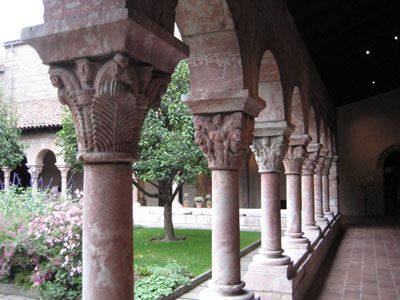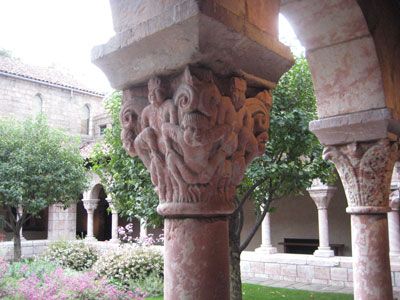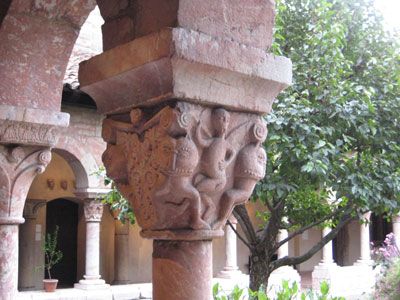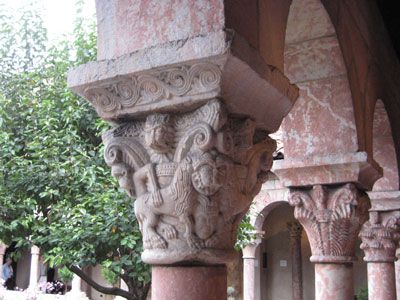The Cuxa Capitals and the Medieval Body
10:03 PM
The cloister from St-Michel-de-Cuxa. The Metropolitan Museum of Art, The Cloisters Collection.
The above image is of the cloister of Saint-Michel-de-Cuxa, in the collection of The Cloisters at The Metropolitan Museum of Art. You may be wondering, why am I posting a picture of stone carvings on a fashion history blog? Well believe it or not, these beautiful stone columns contain valuable information on theories of the medieval body!
Saint-Michel-de-Cuxa was a Benedictine abbey founded in the early ninth century in southwestern France, in the foothills of the Pyrenees. The cloister on display at The Cloisters was constructed between 1130 and 1146, under the direction of the Abbot Gregory. Originally the cloister consisted of sixty-three capitals topping columns arranged in a trapezoidal shape at the south end of the church. The structure at The Cloisters is about half the dimensions of the original, but still conjures the atmosphere and spirit of the original structure. Although the capitols may not be arranged in their original order, the original cloister having been dismantled in the nineteenth century, the carved vignettes were not supposed to be viewed in a specific order or tell a specific story. Instead, they provide individual ideas with which the monk could form a larger narrative.

Cloister capital from St-Michel-de-Cuxa. The Metropolitan Museum of Art, The Cloisters Collection.
There are three different variations of the grotesque present in the capitals of the Cuxa cloister. Some capitals feature naked dancing men, others feature human-animal hybrids such as sirens— half woman, half fish—, and a third type feature strange beasts such as humans and monkeys aping each other or roaring lions devouring men. These strange images provoke ideas of sin. The obscene and ignoble gestures of the dancing men deform the body, therefore deforming the image of God. The sirens represent the dangers of women and lust. The humans imitating the monkeys shows “the degeneration of man into beast” and the roaring lions represent the terrors of the mouth of hell.

Cloister capital from St-Michel-de-Cuxa. The Metropolitan Museum of Art, The Cloisters Collection.
To interpret such images and their place in a cloister, it is necessary to understand the medieval idea of the human body as a microcosm, originally created in Gods image and perfect. The faithful had perfect bodies, and used orderly and elegant gestures which reflected the harmony of their souls. In contrast, those that succumbed to base desires and sin became physically grotesque in their gesture and form, aligning themselves with animals who possess no immortal soul. The physical body was thus seen as a reflection of the inner soul. William of St-Thierry, a Benedictine abbot from the twelfth century, wrote in book two of The Nature of the Body and Soul that man is formed “in the image of him who created [the soul].” The good stand tall “reaching toward heaven and looking up [and this] signifies the imperial and regal dignity of the soul”, while those who “slavishly serve the lusts arising from the senses… have put off the image of the Creator and have put on another image, one that looks at the ground like an animal, one that is beastly.” The grotesques on the Cuxa capitals, representing all sorts of physical and therefore spiritual deformity, would serve as reminders to the monks of the dangers of sin, and subsequently help to shape their behavior.

Cloister capital from St-Michel-de-Cuxa. The Metropolitan Museum of Art, The Cloisters Collection.
Furthermore, the Cuxa capitals and these medieval theories of the body coincide with an interesting moment in textile history! A new sect of Benedictine monks had emerged in 1098, the Cistercians, who believed the Benedictines were too excessive in their way of life, and who had subsequently strayed from the word of God and true religious devotion. The Cistercians sought instead to return to a strict asceticism. One of the ways of doing this was wearing plain white, undyed garments, rather than the traditional black worn by Benedictines. This shift in fashion was mocked by the Benedictine monks. Peter the Venerable described: “I have seen I know not how many black [monks], laughing at a white [monk] whom they meet, as if he were a monster, and showing by their voices and movements that they are amazed….” In the context of medieval religious thought, the grotesque gestures of the laughing monks reflected a grotesqueness of the soul that could easily be connected with the figures on the Cuxa capitals. The capitals therefore would remind a monk, perhaps walking through the arcade and mocking the fashion Cistercians, of the sinfulness of his behavior. The capitals were reminders not only of the greatest sins to be avoided, but of the small ones as well. Even something as simple as a hostile opinion to textiles could deform the soul. Think about that next time you mock some one's outfit!



3 comments